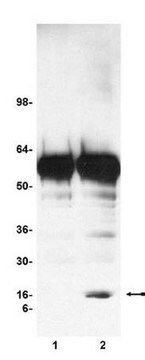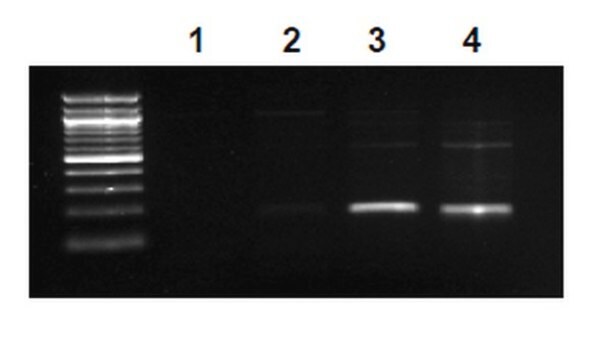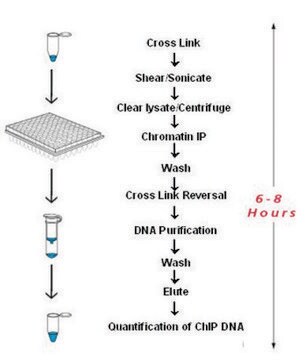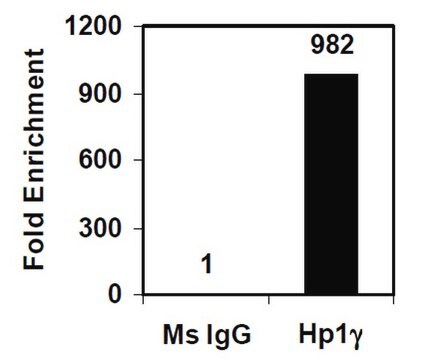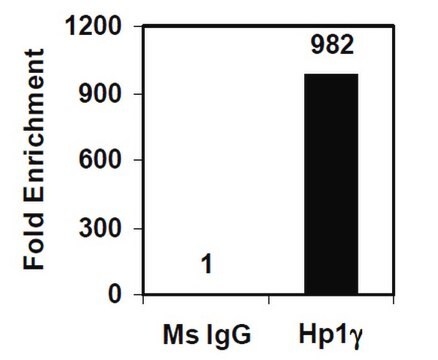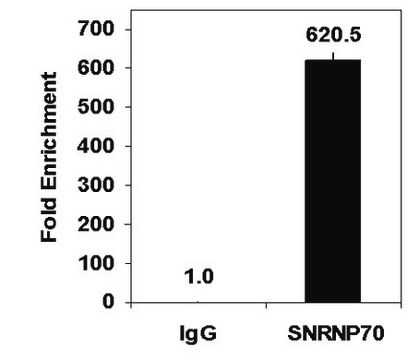17-409
EZ-Magna ChIP® G - Chromatin Immunoprecipitation Kit
Single day chromatin immunoprecipitation (ChIP) kit containing all necessary reagents to perform 22 individual chromatin immunoprecipitation (ChIP) reactions using magnetic G beads. Control primers included.
Sinónimos:
Magnetic ChIP Kit, Magnetic Chromatin Immunoprecipitation
Iniciar sesiónpara Ver la Fijación de precios por contrato y de la organización
About This Item
Código UNSPSC:
12161503
eCl@ss:
32161000
NACRES:
NA.52
Productos recomendados
Nivel de calidad
fabricante / nombre comercial
Magna ChIP®
técnicas
immunoprecipitation (IP): suitable
Condiciones de envío
dry ice
Descripción general
Chromatin Immunoprecipitation (ChIP) is a powerful technique for mapping the in vivo distribution of proteins associated with chromosomal DNA. These proteins can be histone subunits and post-translational modifications or other chromatin associated proteins such as transcription factors, chromatin regulators, etc. Additionally, ChIP can be used to identify regions of the genome associated with these proteins, or conversely, to identify proteins associated with a particular region of the genome. ChIP methodology often involves protein-DNA and protein-protein cross-linking, fragmentation of the cross-linked chromatin, and subsequent immunoprecipitation of chromatin with an antibody specific to a target protein. The DNA fragments isolated in complex with the target protein can be identified by a variety of methods including PCR, DNA microarray and DNA sequencing. Standard or quantitative PCR can be performed to verify whether a particular DNA sequence (the gene or region of the genome) is associated with the protein of interest. The combination of ChIP and promoter or genomic tiling microarrays (ChIP-chip) allows genome-wide identification of DNA-binding sites for chromatin-associated proteins with precise resolution. Alternatively, high-throughput sequencing of libraries constructed from immunoprecipitated chromosomal DNA (ChIP-Seq) is a powerful alternative to ChIP-chip in mapping the protein-DNA interactions across mammalian genomes.
Chromatin Immunoprecipitation (ChIP) is an important technique allowing the researcher to analyze in vivo interactions of proteins with genomic DNA. Any chromatin-associated or DNA binding protein can be analyzed with this technique, provided a good antibody to the protein exists. One can measure different proteins localized to a specific region of the genome, or the genome wide distribution of a specific protein. Another powerful application of this technique is to analyze changes in histone modifications that correlate with processes like transcription, mitosis or DNA repair.
Features & Benefits:
Faster: Magnetic protein G beads allow for the entire ChIP protocol to be done in as little as a day! All reagents to process your samples are included - you don′t have to spend valuable time making them.
Easier: Spin columns make DNA purification easier and more reliable - no more messy phenol-chloroform extractions.
Greater Reproducibility: Positive and negative control antibodies and PCR primers are included to help validate your results and to troubleshoot your experiments.
Features & Benefits:
Faster: Magnetic protein G beads allow for the entire ChIP protocol to be done in as little as a day! All reagents to process your samples are included - you don′t have to spend valuable time making them.
Easier: Spin columns make DNA purification easier and more reliable - no more messy phenol-chloroform extractions.
Greater Reproducibility: Positive and negative control antibodies and PCR primers are included to help validate your results and to troubleshoot your experiments.
Aplicación
Used to detect/quantify: Protein G
Envase
Kit capacity: 22 chromatin immunoprecipitation assays
Componentes
Magnetic Protein G Beads
ChIP Dilution Buffer
Low Salt Wash Buffer
High Salt Wash Buffer
LiCl Wash Buffer
TE Buffer
Cell Lysis Buffer
Nuclear Lysis Buffer
ChIP Elution Buffer (w/o Proteinase K)
10X Glycine
10X PBS
Protease Inhibitor Cocktail II
Proteinase K
Control Primers
Anti-RNA Polymerase II
Normal Mouse IgG
Spin Filters
Collection Tubes
Bind Reagent A
Wash Reagent B
Elution Reagent C
ChIP Dilution Buffer
Low Salt Wash Buffer
High Salt Wash Buffer
LiCl Wash Buffer
TE Buffer
Cell Lysis Buffer
Nuclear Lysis Buffer
ChIP Elution Buffer (w/o Proteinase K)
10X Glycine
10X PBS
Protease Inhibitor Cocktail II
Proteinase K
Control Primers
Anti-RNA Polymerase II
Normal Mouse IgG
Spin Filters
Collection Tubes
Bind Reagent A
Wash Reagent B
Elution Reagent C
Forma física
Two boxes containing all necessary reagents to perform 22 individual chromatin immunoprecipitation (ChIP) reactions. Supplied buffers are sufficient to generate chromatin from up to five 15 cm plates of cultured cells, each plate providing up to 10 chromatin preparations (varies with cell and assay type).
Almacenamiento y estabilidad
Upon receipt, store components at the temperatures indicated on the labels. Kit components are stable for 1 year from date of shipment when stored as directed.
Información legal
MAGNA CHIP is a registered trademark of Merck KGaA, Darmstadt, Germany
Cláusula de descargo de responsabilidad
Unless otherwise stated in our catalog or other company documentation accompanying the product(s), our products are intended for research use only and are not to be used for any other purpose, which includes but is not limited to, unauthorized commercial uses, in vitro diagnostic uses, ex vivo or in vivo therapeutic uses or any type of consumption or application to humans or animals.
Palabra de señalización
Danger
Frases de peligro
Consejos de prudencia
Clasificaciones de peligro
Acute Tox. 4 Oral - Aquatic Chronic 3 - Eye Irrit. 2 - Flam. Liq. 2 - Skin Irrit. 2
Código de clase de almacenamiento
3 - Flammable liquids
Punto de inflamabilidad (°F)
55.4 °F
Punto de inflamabilidad (°C)
13 °C
Certificados de análisis (COA)
Busque Certificados de análisis (COA) introduciendo el número de lote del producto. Los números de lote se encuentran en la etiqueta del producto después de las palabras «Lot» o «Batch»
¿Ya tiene este producto?
Encuentre la documentación para los productos que ha comprado recientemente en la Biblioteca de documentos.
Host factor PRPF31 is involved in cccDNA production in HBV-replicating cells.
Kinoshita, W; Ogura, N; Watashi, K; Wakita, T
Biochemical and biophysical research communications null
Magdalena M Przybycien-Szymanska et al.
PloS one, 6(10), e26647-e26647 (2011-11-01)
EtOH exposure in male rats increases corticotropin-releasing hormone (CRH) mRNA in the paraventricular nucleus of the hypothalamus (PVN), a brain region responsible for coordinating stress and anxiety responses. In this study we identified the molecular mechanisms involved in mediating these
Resistin impairs SIRT1 function and induces senescence-associated phenotype in hepatocytes.
Yu, A; Zheng, Y; Zhang, R; Huang, J; Zhu, Z; Zhou, R; Jin, D; Yang, Z
Molecular and cellular endocrinology null
COUP-TFII controls amygdala patterning by regulating neuropilin expression.
Tang, K; Rubenstein, JL; Tsai, SY; Tsai, MJ
Development null
Overexpression of Rap-1A indicates a poor prognosis for oral cavity squamous cell carcinoma and promotes tumor cell invasion via Aurora-A modulation.
Chen, CH; Chuang, HC; Huang, CC; Fang, FM; Huang, HY; Tsai, HT; Su, LJ; Shiu, LY; Leu, S; Chien, CY
The American Journal of Pathology null
Nuestro equipo de científicos tiene experiencia en todas las áreas de investigación: Ciencias de la vida, Ciencia de los materiales, Síntesis química, Cromatografía, Analítica y muchas otras.
Póngase en contacto con el Servicio técnico